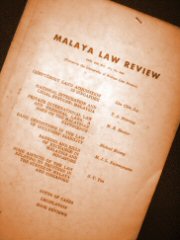|
Archive |
2386 records match your query:
| 201. | SEPTEMBER 2016 Issue | p.378 | |
| | Book Reviews: Lord Sumption and the Limits of the Law by Nicholas Barber, Richard Ekins and Paul Yowell, eds
Michael W Dowdle • [2016] Sing JLS 378 (Sep)On 20 November 2013, Jonathan Philip Chadwick Sumption, a Justice of the Supreme Court of the United Kingdom since 2012, delivered the 27th Sultan Azlan Shah Lecture in Kuala Lumpur. Entitled "The Limits of Law", it explored the role that judicial review should play in a democratic system, expressing concern that particularly insofar as questions of fundamental rights are concerned, the English courts' expanding resort to judicial review was increasingly impinging upon political terrain that is more properly the purview of parliament. His argument along these lines derived primarily from two claims. The first is that judicial modes of investigation, which generally limit their focus to the concerns of the parties before the court, are inappropriate in the context of the much more polycentric nature of questions of fundamental rights
| | 202. | SEPTEMBER 2016 Issue | p.385 | |
| | Book Reviews: Diversity in Intellectual Property: Identities, Interests and Intersections by Irene Calboli and Srividhya Ragavan, eds
Susanna H S Leong • [2016] Sing JLS 385 (Sep)It is true that the term "intellectual property" ("IP") may give to the uninitiated the impression that it refers to a homogenous or unified subject matter. It is also true that not too long ago, at most a couple of decades, the then-prevailing thought leadership in IP was that in order to promote trade and to create a level playing field, a gradual harmonisation of IP rights in the world by the incorporation of minimum standards into international trade agreements was both necessary and justifiable. It is further true that the IP protection regime, perceived as a unified body of law, has become an integral part of international trade negotiations and has never been more economically and politically important than the present day. Nevertheless, the quest for a "one size fits all" regime in the IP system has increasingly been subject to question particularly in light of the fact that IP comprises historically distinct regimes of patent, copyright and trade mark law which differ greatly in terms of historical origins, policy objectives, scope of protection as well as social and commercial impact; even as we acknowledge that the rationale for protection is based primarily on theories of utilitarian incentives. Considered from this perspective, diversity is thus an integral and unique trait of IP that must be constantly borne in mind as well as embraced as we navigate the plethora of issues in this complex area.
| | 203. | SEPTEMBER 2016 Issue | p.389 | |
| | Book Reviews: Constitutional Interpretation in Singapore—Theory and Practice by Jaclyn L Neo, ed
Maartje de Visser • [2016] Sing JLS 389 (Sep)Jaclyn Neo's edited volume Constitutional Interpretation in Singapore—Theory and Practice is nicely situated at the confluence of two themes that are du jour in the constitutional law discourse: the methodological turn towards more empiricism and an academic infatuation with determining the proper role of courts within the system.
| | 204. | MARCH 2016 Issue | p.1 | |
| | Cross-Border Cooperation in Bank Resolution: A Framework for Asia
Vivien Chen, Andrew Godwin and Ian Ramsay • [2016] Sing JLS 1 (Mar)This paper identifies challenges to cross-border cooperation in Asia in the area of bank resolution and potential measures to enhance cooperation. In line with the consensus-based approach that is common in Asia, these measures include strengthening regulatory harmonisation and promoting convergence in supervisory practices through the use of non-binding guidelines. Drawing on the experience in the EU and the Trans-Tasman cooperation between Australia and New Zealand, the paper proposes that convergence-promoting functions be incorporated within existing institutions and considers the use of resolution colleges. In addition, acknowledging the preference in Asia for bilateral arrangements over multilateral arrangements, the paper suggests ways in which information sharing and recognition of foreign resolution action can be enhanced and draws on the experience of Singapore for this purpose.
[Full Text]
| | 205. | MARCH 2016 Issue | p.29 | |
| | The CISG as a Model Law: A Comparative Law Approach
Angelo Chianale • [2016] Sing JLS 29 (Mar)In this article I adopt a comparative law approach to illustrate the coexistence of various models governing the sale of goods, and their classification on the basis of two main characteristics: the transfer of property and the opposition certainty/flexibility. I use this approach to analyse the United Nations Convention on Contracts for the International Sale of Goods.1 Then I examine how the CISG influenced several national systems and can influence future attempts at regional harmonisation. I conclude with the reasons that in my opinion make the CISG a good model for the sale of goods (prestige, equilibrium and derogability), and with the desirable future developments.
| | 206. | MARCH 2016 Issue | p.46 | |
| | The Doing Business Index on Minority Investor Protection: The Case of Singapore
Lin Lin and Michael Ewing-Chow • [2016] Sing JLS 46 (Mar)The World Bank's Ease of Doing Business index has significantly affected regulations and policies regarding corporate matters around the world, and yet there has been scant academic attempt examining the use and implication of the index, especially in the area of investor protection, which is an essential element in doing business. In this paper, we examine in depth the research methodologies employed by the Doing Business project in measuring the strength of investor protection, especially in light of the recent renaming of this indicator from Protecting Investors to Protecting Minority Investors in Doing Business 2015. Using Singapore as a case study, we argue that, notwithstanding the positive changes brought in by Doing Business 2015, the variables and components chosen in this indicator essentially fail to capture the salient features of minority investor protection. We argue that minority investor protection is an area that is inherently too context-specific to be evaluated based on a unified business assumption or by pure quantitative methods. Lastly, we also provide specific suggestions to improve the Protecting Minority Investors indicator.
| | 207. | MARCH 2016 Issue | p.70 | |
| | Contracts Governing the Use of Websites
Eliza Mik • [2016] Sing JLS 70 (Mar)With the progressive transformation of the Internet from a romanticised instrument of freedom and self-expression into a commercial platform for digital distribution, most websites must be recognised as access interfaces to a wide range of content and services. This paper examines the contracts purportedly governing the use of such content and services. It explores the difficulties of establishing legal intention in a context that is not unambiguously commercial or transactional and contrasts popular beliefs with the basic principles of contract law. It draws a clear distinction between contracts governing traditional e-commerce exchanges, such as buying books on Amazon.com, and contracts governing the very use of websites. In the latter instance, the website (ie the resources made available thereon) constitutes the subject matter of the transaction. Equal importance must be attributed to the fact that such contracts are formed on websites and to the fact that they govern their use. The website user will question the existence of a contract on the basis that he did not have an intention to be legally bound, or had no awareness that a transaction was taking place. The website operator will argue that, objectively, all prerequisites of a legally enforceable agreement have been met. The outcome of the discussion will, to a large extent, depend on whether the user's beliefs and expectations can be regarded as reasonable and on whether it is the user or the operator who deserves the protection of the objective theory of contract.
| | 208. | MARCH 2016 Issue | p.95 | |
| | Equal Protection and the Reasonable Classification Test in Singapore: After Lim Meng Suang v Attorney-General
Jaclyn L Neo • [2016] Sing JLS 95 (Mar)The realisation of the almost universally accepted ideal of equality as a legal doctrine is complicated by the fact that differentiation is an inherent part of regulation in the modern state. In Singapore, the courts have regarded the Constitution"s injunction for the equal protection of the law to be a relative, rather than an absolute, concept. Differentiating laws therefore only has to satisfy a reasonable classification test in order to pass constitutional muster. This article argues that despite recent judgments elaborating upon the scope and meaning of the equality clause, there remains at least three areas in need of further judicial elucidation. It further argues that the reasonable classification test as it now stands is sufficiently capacious for the courts to read substantive content into the equality provision should a suitable case arise in the future.
| | 209. | MARCH 2016 Issue | p.118 | |
| | The Extraneous Factors Rule in Trademark Law: Avoiding Confusion or Simply Confusing?
David Tan and Benjamin Foo • [2016] Sing JLS 118 (Mar)The Singapore Court of Appeal's recent decision in Staywell clearly signalled a rejection of the European "global appreciation approach" when evaluating trademark infringement. By adopting a pro-mark ethos, the Court had chosen to ignore certain factors that might affect the consumers' purchasing decision by excluding extraneous factors that could potentially negate the finding of likelihood of confusion based solely on marks-similarity and goods-similarity. This article argues that Singapore courts could consider American jurisprudence when examining "likelihood of confusion" under trademark infringement claims, such as an evaluation of the Polaroid factors, to discern factors which have an impact and effect on the consumers' purchasing decision in order to better illuminate whether the average consumer is likely to be confused. It proposes a four-stage test which integrates the US likelihood of confusion factors into the autochthonous approach advanced in Staywell. Not only is this formulation consistent with the wording of the Trade Marks Act, it would strike a better balance between protecting the proprietary right of the registered mark owner and promoting entrepreneurship and business certainty in a manner that is consonant with consumer purchasing behaviour.
| | 210. | MARCH 2016 Issue | p.149 | |
| | Management Corporation: Common Property and Structural Defects
Teo Keang Sood • [2016] Sing JLS 149 (Mar)This article looks at three aspects involving a management corporation in a strata development. It is argued that the principle laid down in the New SouthWales cases that a management corporation holds the common property as trustee for the unit owners has no application in the Singapore context. In light of the various difficulties faced by a management corporation in pursuing actions in contract and tort for unit owners in respect of the common property, legislative intervention to confer on the management corporation a cause of action in its own right is justified. Finally, greater clarity on what amounts to structural defects in a strata development would be welcomed as it would greatly assist a management corporation in discharging its duty in this respect.
| |
|
|


 |







